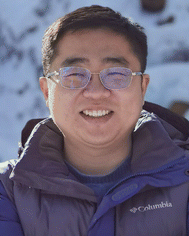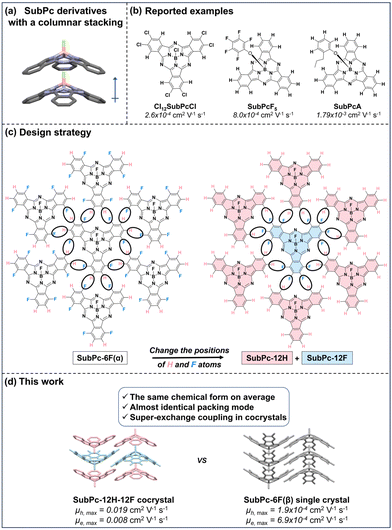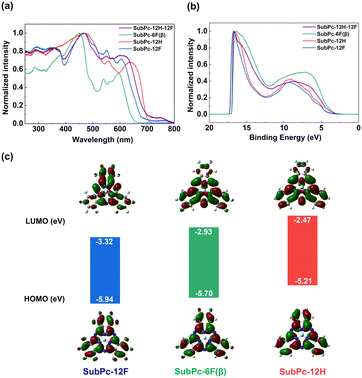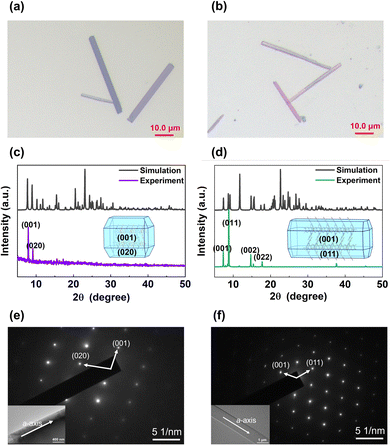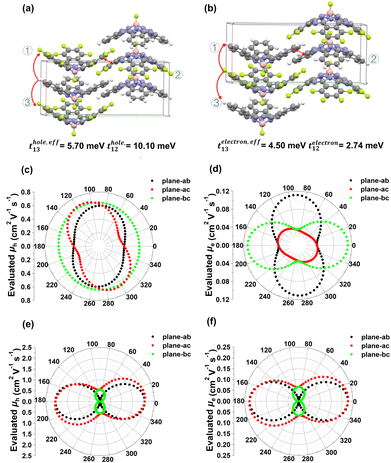Subphthalocyanine semiconducting cocrystals with efficient super-exchange coupling†
Lingyan
Sun
a,
Yuan
Guo
*bc,
Dan
He
d,
Barun
Dhara
e,
Fei
Huang
a,
Yuanping
Yi
 c,
Daigo
Miyajima
*f and
Cheng
Zhang
c,
Daigo
Miyajima
*f and
Cheng
Zhang
 *a
*a
aKey Laboratory of Green Chemistry and Technology of Ministry of Education, College of Chemistry, Sichuan University, Chengdu 610064, P. R. China. E-mail: cheng.zhang@scu.edu.cn
bSchool of Light Industry and Engineering, Qilu University of Technology (Shandong Academy of Sciences), Jinan 250353, P. R. China. E-mail: yguo@qlu.edu.cn
cBeijing National Laboratory for Molecular Sciences, CAS Key Laboratory of Organic Solids, Institute of Chemistry, Chinese Academy of Sciences, Beijing 100190, P. R. China
dCollege of Chemistry and Chemical Engineering, Central South University, Changsha 410083, P. R. China
eRIKEN Center for Emergent Matter Science, 2-1 Hirosawa, Wako, Saitama 351-0198, Japan
fSchool of Science and Engineering, The Chinese University of Hong Kong, Shenzhen 518172, P. R. China. E-mail: dmiyajima@cuhk.edu.cn
First published on 27th February 2024
Abstract
Organic cocrystals have attracted widespread research attention due to their unique properties. However, the development of crystal engineering is relatively slow because of the difficulty in designing the molecular structures and controlling the intermolecular interactions. Here, we report a subphthalocyanine (SubPc) cocrystal (SubPc-12H-12F) through preciously regulating hydrogen bonds and donor–acceptor interactions. The cocrystal forms a perfect one-dimensional columnar assembly and shows an almost identical packing mode with a one-component single crystal SubPc-6F(β), which provides an ideal example to study the super-exchange coupling in cocrystals. The SubPc-12H-12F cocrystal exhibits ambipolar transport properties with an improved hole mobility of 0.019 cm2 V−1 s−1 by two orders of magnitude compared with SubPc-6F(β). The cocrystals of SubPc-12H-12F exhibit the highest mobilities ever reported among SubPc derivatives and surpass the order of 10−2 cm2 V−1 s−1 for the first time. Theoretical calculations indicated that the super-exchange coupling in cocrystals can both increase the charge carrier mobility and expand the charge transport channels, which holds the potential to further predictions for high-performance cocrystals.
Introduction
With the rapid advances in crystal engineering and supramolecular chemistry, organic cocrystals exhibit significant potential in materials science, such as room-temperature phosphorescence,1–4 charge transport properties,5–7 ferroelectricity,8–13 bulk photovoltaic effects,14etc. Compared with chemical synthesis to construct high-performance materials, the development of crystal engineering still lags far behind because of the difficulty in designing the molecular structures, controlling the intermolecular interactions, and matching the solubilities.15,16 In contrast with planar-shape semiconductors, bowl-shaped conjugated molecules with concave–convex complementary structures are more likely to form columnar packing, which results in a limited π-surface overlap and inferior charge transport.17–20 Recently, organic cocrystalline semiconductors with two or more different components in a stoichiometric ratio have unique ambipolar charge transport characteristics and have revealed the structure–property relationships at molecular levels, which emerges as promising research interest in materials science.21–24 However, the reported charge carrier mobilities of bowl-shaped cocrystals are still at the order of 10−1 cm2 V−1 s−1 magnitude.25–27 Subphthalocyanines (SubPcs) are a class of conjugate molecules with a bowl-shaped structure, which are composed of a central boron atom, three isoindole units and an axial ligand.28–30 The unique bowl-shaped structure of SubPcs results in a large dipole moment in the axial direction and are applied in organic solar cells,31–34 organic photodetectors,30,35 nonlinear optics,28,36 singlet fission,37–39etc., recently. By using the fluoride atom as the axial ligand, Torres et al.40,41 reported the perfect one-dimensional assemblies of SubPcs (Fig. 1a). These one-dimensional columns amplify the dipole moment and are convenient for charge separation and transport. However, SubPcs were rarely applied in the field of charge transport and the mobilities of SubPcs were only at 10−3 cm2 V−1 s−1 level as the highest (Fig. 1b) because of the limited π–π interactions.42–44In this study, we chose SubPc as a model compound to construct cocrystals through precisely modulating the intermolecular interactions. This cocrystal exhibits ambipolar charge transport properties in organic field-effect transistor (OFET) devices. To our surprise, the hole mobilities of cocrystals improve two orders of magnitude to the SubPc single crystals with almost identical packing and surpass the order of 10−2 cm2 V−1 s−1, while 8.5 times for the electron mobilities. Furthermore, theoretical calculations unveiled the importance of the super-exchange effect45–47 in cocrystals for the remarkable enhancement in carrier mobilities. We believe that this design strategy as well as the super-exchange effect evaluation will open up new avenues for the study of charge transport in organic cocrystals and the design of high-performance bowl-shaped semiconductors.
Results and discussion
Previously, we reported a design strategy to build polar SubPc crystals with a trigonal lattice through hydrogen bond modulation, for instance, SubPc-6F(α) with half and half fluoride and hydrogen atoms at isoindole units.48 If we separate all fluoride and hydrogen atoms of SubPc-6F(α) into two different molecules, SubPc-12F and SubPc-12H (Fig. 1c), we assume that the same molecular packing can also be depicted because the same hydrogen bond networks are expected. To the best of our knowledge, the SubPc-SubPc cocrystals are unprecedented.49–51We synthesized SubPc-12H and SubPc-12F according to the reported literature studies.40,52 After numerous attempts, SubPc-12H-12F cocrystals were finally obtained with a 1![[thin space (1/6-em)]](https://www.rsc.org/images/entities/char_2009.gif) :
:![[thin space (1/6-em)]](https://www.rsc.org/images/entities/char_2009.gif) 1 mole ratio of SubPc-12H and SubPc-12F both from a solvent diffusion method (mixture of CHCl3 and ethanol) and a physical vapor transport (PVT) process (Fig. S11 and Table S4, ESI†). Especially, in the PVT process, SubPc-12H and SubPc-12F were placed at each side of the glass tube and the SubPc-12H-12F cocrystals were gradually formed in the middle of the tube by cosublimation. The schematic diagram and the sublimation conditions of the PVT process are shown in Fig. S11a and Table S4 (ESI†). After X-ray structural analysis, we surprisingly found that the stacking modes are quite similar to the single crystals of SubPc-6F(β) we reported previously.48 The details will be discussed below.
1 mole ratio of SubPc-12H and SubPc-12F both from a solvent diffusion method (mixture of CHCl3 and ethanol) and a physical vapor transport (PVT) process (Fig. S11 and Table S4, ESI†). Especially, in the PVT process, SubPc-12H and SubPc-12F were placed at each side of the glass tube and the SubPc-12H-12F cocrystals were gradually formed in the middle of the tube by cosublimation. The schematic diagram and the sublimation conditions of the PVT process are shown in Fig. S11a and Table S4 (ESI†). After X-ray structural analysis, we surprisingly found that the stacking modes are quite similar to the single crystals of SubPc-6F(β) we reported previously.48 The details will be discussed below.
As shown in Fig. 2, both SubPc-12H-12F cocrystals and SubPc-6F(β) single crystals assemble in one-dimensional columns with antiparallel orientations. The two components in SubPc-12H-12F cocrystals perform the ABAB stacking mode in columns. These crystals are monoclinic with a P21/m space group. As summarized in Table 1, SubPc-12H-12F cocrystals have similar cell parameters (b, c, α, β, and γ) and B–B distance and π–π distance to SubPc-6F(β). The double a-axis value of SubPc-12H-12F is attributed to the two components in cocrystals. The intermolecular interactions of SubPc-12H-12F and SubPc-6F(β) were evaluated by Hirshfeld surface analysis53 (Fig. S5 and S6, ESI†). The profiles of intermolecular interactions in SubPc-12H-12F and SubPc-6F(β) are almost the same as expected. Besides, due to the electrostatic force coming from the donor and acceptor in columns, the bowl depths of SubPc-12H and SubPc-12F in SubPc-12H-12F cocrystals are 2.79 and 2.89 Å, deeper than the ones in SubPc-12H (2.48 Å) and SubPc-12F (2.71 Å) single crystals, respectively (Fig. S3, S4 and Table S1, ESI†). At the same time, the larger density of the SubPc-12H-12F cocrystal indicates closer stackings compared with that of the SubPc-6F(β), which may be more efficient for charge transport. As a result, SubPc-12H-12F and SubPc-6F(β) have the same chemical form on average and almost identical packing modes, which provide an ideal instance to investigate the super-exchange couplings in cocrystals and compare the charge transport properties in cocrystals and mono-component single crystals.
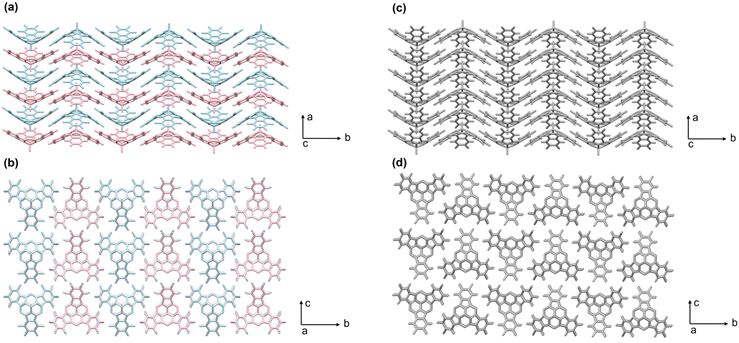 | ||
| Fig. 2 X-ray crystal structures of (a) and (c) side views and (b) and (d) top views of (a) and (b) SubPc-12H-12F and (c) and (d) SubPc-6F(β). | ||
| Crystals | SubPc-12H-12F | SubPc-6F(β) |
|---|---|---|
| a CCDC 2288075. b From ref. 12. c The distances were the shortest among the three SubPc arms. | ||
| Crystal system | Monoclinic | Monoclinic |
| Crystal symmetry | C 2h | C 2h |
| Space group | P21/m | P21/m |
| a [Å] | 8.6916(2) | 4.3804(10) |
| b [Å] | 19.7951(5) | 19.3454(5) |
| c [Å] | 11.5578(3) | 12.1264(4) |
| α [°] | 90 | 90 |
| β [°] | 95.196(7) | 99.012(3) |
| γ [°] | 90 | 90 |
| V [Å3] | 1980.36(9) | 1014.91(5) |
| Density [g cm−3] | 1.751 | 1.709 |
| R [%] | 4.57 | 4.34 |
| R w [%] | 11.12 | 11.55 |
| B–B distance [Å] | 4.35 | 4.38 |
| π–π distancec [Å] | 3.50 | 3.50 |
The UV/Vis absorption spectra, electrochemical cyclic voltammograms (CVs) and ultraviolet photoelectron spectra (UPS) were recorded to explore the photophysical and electrochemical properties of crystals. Samples for UPS measurements were prepared by PVT methods onto ITO substrates. The data of SubPc-12H-12F cocrystals, SubPc-6F(β), SubPc-12H and SubPc-12F single crystals are summarized in Fig. 3 and Table 2. All the crystals exhibit broad absorption in the visible region. The maximum absorption values of SubPc-12H-12F, SubPc-6F(β), SubPc-12H and SubPc-12F crystals are 612, 595, 639, and 606 nm, respectively. With the decreased number of electron-withdrawing F atoms, the highest occupied molecular orbital (HOMO) and the lowest unoccupied molecular orbital (LUMO) energy levels of SubPc-12F, SubPc-6F(β) and SubPc-12H estimated from CV in dilute CH2Cl2 (Fig. S8–S10 and Table S3, ESI†) are increased gradually from −5.71 to −5.32 eV and −3.85 to −3.33 eV, respectively. The tendency evaluated from the density functional theory (DFT) calculation (Fig. 3c) agrees well with the experimental data. Meanwhile, we also calculated the HOMO energy levels of these four crystals from UPS spectra with almost identical edge shapes. The increments of the HOMO energy levels of SubPc-12F (−6.06 eV), SubPc-6F(β) (−5.81 eV), and SubPc-12H (−5.09 eV) crystals are consistent with those calculated from CV measurements. Importantly, the HOMO energy level of SubPc-12H-12F (−5.86 eV) cocrystals is similar to that of SubPc-6F(β) and in between with SubPc-12H and SubPc-12F, which demonstrates that the energy levels of cocrystals can also be fine-tuned like single crystals.54–56
| Materials | λ max [nm] | E g [eV] | HOMOc [eV] |
|---|---|---|---|
| a Absorption maxima of crystals. b The optical bandgaps were calculated according to Eg = 1240/λonset, where λonset is the onset value of the absorption spectrum in the long wavelength region. c Estimated from the empirical equation HOMO = WF + Eb (eV), where WF is the d-value between 21.22 and the onset value of the high binding energy, and Eb is the onset value of the low binding energy. | |||
| SubPc-12H-12F | 612 | 1.77 | −5.86 |
| SubPc-6F(β) | 595 | 1.92 | −5.81 |
| SubPc-12H | 639 | 1.78 | −5.09 |
| SubPc-12F | 606 | 1.83 | −6.06 |
As shown in Fig. 4a and b, the needle-like purple-red crystals of SubPc-12H-12F and SubPc-6F(β) could be obtained regardless of the solvent diffusion or the PVT method. To figure out the molecular orientations of SubPc-12H-12F and SubPc-6F(β), X-ray diffraction (XRD, Fig. 4c and d) and selected-area electron diffraction (SAED, Fig. 4e and f) were performed. The XRD patterns exhibit sharp diffraction peaks at 7.91° (d = 11.29 Å) and 9.12° (d = 9.69 Å) in SubPc-12H-12F and 7.33° (d = 12.01 Å) and 8.73° (d = 10.03 Å) in SubPc-6F(β), which are consistent with the simulated patterns, indicating that the planes (001), (020) and (001), (011) are dominant when SubPc-12H-12F and SubPc-6F(β) evaporate on substrates, respectively. After simulating the growth morphologies (the inset of Fig. 4e and f) based on the Bravais–Friedel–Donnay–Harker (BFDH) method using the Mercury program,57 we found that they are in agreement with the crystal shapes in optical images and the dominant crystal planes in XRD results. All the SAED patterns by transmission electron microscopy can also be indexed from the XRD analysis. As a result, the columns are arranged along the long axis (a-axis) in both SubPc-12H-12F cocrystals and SubPc-6F(β) single crystals.
We fabricated the single crystal OFETs with a bottom-gate top-contact (BGTC) configuration and checked the performance along the long axis of crystals. The SubPc-12H-12F cocrystals and SubPc-6F(β) single crystals were sublimated onto octadecyltrichlorosilane (OTS)-modified SiO2 (300 nm)/Si substrates, and then 60 nm gold was evaporated as the source and drain electrodes (Fig. S12 and S13, ESI†). The representative transfer and output curves of devices based on SubPc-12H-12F and SubPc-6F(β) are shown in Fig. 5a, b and Fig. S14 (ESI†), respectively, and the device characteristics are summarized in Table 3, demonstrating typical features of ambipolar transporting organic semiconductors. The mobilities are extracted from at least 10 devices and the maximum values and the statistical results are illustrated in Fig. 5c and d. For SubPc-6F(β), the average hole and electron mobilities are 1.1 × 10−4 and 6.4 × 10−4 cm2 V−1 s−1 with maximum values of 1.9 × 10−4 and 9.1 × 10−4 cm2 V−1 s−1, respectively. Whereas for SubPc-12H-12F, the average hole and electron mobilities are increased to 0.012 and 0.003 cm2 V−1 s−1 with the maximum values reaching 0.019 and 0.008 cm2 V−1 s−1, respectively. Unexpectedly, the maximum mobilities of SubPc-12H-12F for holes and electrons are 100 and 8.5 times higher than those of SubPc-6F(β), despite sharing the same chemical form on average and exhibiting almost identical packing arrangements. As far as we are aware, the SubPc-12H-12F cocrystals exhibit the highest mobilities up to date in SubPc derivatives and surpass the order of 10−2 cm2 V−1 s−1 for the first time.
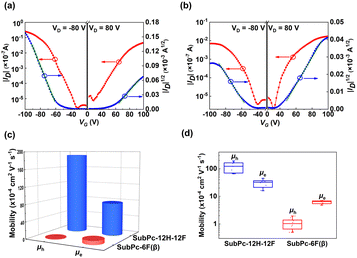 | ||
| Fig. 5 The representative transfer curves of (a) SubPc-12H-12F and (b) SubPc-6F(β) in OFET devices. (c) The maximum and (d) the statistical mobilities of SubPc-12H-12F and SubPc-6F(β). | ||
| Materials | Hole mobility | Electron mobility | ||||
|---|---|---|---|---|---|---|
| μ h [×10−4 cm2 V−1 s−1] | V th [V] | I on/off | μ e [×10−4 cm2 V−1 s−1] | V th [V] | I on/off | |
| a Averaged from 10 devices. The devices were tested under a N2 atmosphere. | ||||||
| SubPc-12H-12F | 191.0 (122.0) | −25 (−51) | 105 (104) | 77.5 (30.4) | 20 (43) | 104 (103) |
| SubPc-6F(β) | 1.9 (1.1) | −26 (−44) | 104 (103) | 9.1 (6.4) | 24 (35) | 104 (103) |
To delve into why SubPc-12H-12F cocrystals exhibit enhanced mobilities than SubPc-6F(β) single crystals, we further conducted theoretical calculations. First, the transfer integrals and reorganization energies were estimated based on the crystal data (Fig. S15 and Table S5, ESI†). The reorganization energies of both crystals are similar for holes (146 meV for SubPc-12H-12F and 120 meV for SubPc-6F(β)) and electrons (310 meV for SubPc-12H-12F and 300 meV for SubPc-6F(β)), respectively. The dimer of SubPc-6F(β) in a column has much bigger transfer integral (t1) values than that of SubPc-12H-12F for both hole and electron transports. Meanwhile, the little t2 values of dimers in adjacent columns indicate only one dimensional (1D) channel for charge transport in both SubPc-12H-12F cocrystals and SubPc-6F(β) single crystals. The anisotropy mobility evaluation of SubPc-6F(β) (Fig. 6e and f) shows the same tendency, which could only transport along a-axis. Although the transfer integrals and reorganization energy calculations suggested that SubPc-6F(β) should exhibit superior device performance, the experimental results yielded contradictory outcomes. Next, we examined the super-exchange couplings, which are derived in a D–A–D or A–D–A triad system in organic D–A cocrystals and copolymers.45–47 Because of the ambipolar transport characteristics of SubPc-12H-12F, we assumed that holes could transport from molecule 1 to 3, resulting in a super-exchange coupling value of 5.70 meV (Fig. 6a). Notably, multiple super-exchange coupling triads exist in this cocrystal. When considering only this triad for evaluating carrier mobility, we observed an increase in hole mobility from 0.53 to 0.93 cm2 V−1 s−1, surpassing 0.89 cm2 V−1 s−1 of SubPc-6F(β) estimated through the semi-classical Marcus (Table S6, ESI†). Simultaneously (Fig. 6b), the electron mobility can be improved from 0.059 to 0.086 cm2 V−1 s−1, exceeding 0.076 cm2 V−1 s−1 of SubPc-6F(β). Moreover, in SubPc-12H-12F cocrystals, the channels for charge transport extend from 1D to 2D for electrons (Fig. 6d) and even 3D for holes (Fig. 6c) due to super-exchange coupling, resulting in higher hole mobilities than those of electrons. These calculation results demonstrate that the super-exchange coupling plays an important role in charge transport in cocrystals. The presence of multiple channels in SubPc-12H-12F cocrystals facilitates the smoother transport of charge carriers, as they can switch to an alternative channel in the case of defects. Conversely, charge carriers tend to be trapped in SubPc-6F(β). Consequently, cocrystals have the potential to obtain higher mobilities compared to single crystals with analogous packings.
Conclusions
In summary, we have successfully obtained SubPc-12H-12F cocrystals through precious molecular design. Notably, SubPc-12H-12F demonstrates ambipolar transport characteristics, exhibiting hole and electron mobilities up to 0.019 and 0.008 cm2 V−1 s−1, respectively. These values are significantly elevated compared to SubPc-6F(β), displaying an increase of 100 and 8.5 times, respectively, despite their nearly identical packing modes. This marks the first instance of enhancing SubPcs’ mobilities to the order of 10−2 cm2 V−1 s−1 through crystal engineering. Moreover, the super-exchange coupling in cocrystals not only enhances carrier mobility but also broadens the charge transport channels. This observation is in excellent agreement with the experimental findings. Thus, our approach, combining theoretical calculations with strategic design, holds the potential to further predictions for high-performance bowl-shaped cocrystals. We trust that this contribution will advance the field of organic cocrystal materials.Conflicts of interest
The authors declare no competing interests.Acknowledgements
We acknowledge the financial support from the National Natural Science Foundation of China (22205150, 22203049, and 52272056) and the Fundamental Research Funds for the Central Universities. We also thank the help of Yunfei Tian from the Analytical & Testing Center of Sichuan University and Feng Yang from the Comprehensive Training Platform of the Specialized Laboratory in the College of Chemistry at Sichuan University for the UPS measurement and TEM test, respectively.References
- A. Abe, K. Goushi, M. Mamada and C. Adachi, Adv. Mater., 2023, 2211160 CrossRef PubMed
.
- L. Ma, Y. Liu, H. Tian and X. Ma, JACS Au, 2023, 3, 1835 CrossRef CAS PubMed
.
- T. Zhang, X. Ma, H. Wu, L. Zhu, Y. Zhao and H. Tian, Angew. Chem., Int. Ed., 2020, 59, 11206 CrossRef CAS PubMed
.
- J. Yang, M. Fang and Z. Li, Acc. Mater. Res., 2021, 2, 644 CrossRef CAS
.
- L. Sun, Y. Wang, F. Yang, X. Zhang and W. Hu, Adv. Mater., 2019, 31, 1902328 CrossRef PubMed
.
- F. Li, L. Zheng, Y. Sun, S. Li, L. Sun, F. Yang, W. Dong, X. Zhang and W. Hu, Sci. China: Chem., 2023, 66, 266 CrossRef CAS
.
- J. Zhang, J. Tan, Z. Ma, W. Xu, G. Zhao, H. Geng, C. Di, W. Hu, Z. Shuai, K. Singh and D. Zhu, J. Am. Chem. Soc., 2013, 135, 558 CrossRef CAS PubMed
.
- Y. Huang, Z. Wang, Z. Chen and Q. Zhang, Angew. Chem., Int. Ed., 2019, 58, 9696 CrossRef CAS PubMed
.
- A. S. Tayi, A. K. Shveyd, A. C.-H. Sue, J. M. Szarko, B. S. Rolczynski, D. Cao, T. J. Kennedy, A. A. Sarjeant, C. L. Stern, W. F. Paxton, W. Wu, S. K. Dey, A. C. Fahrenbach, J. R. Guest, H. Mohseni, L. X. Chen, K. L. Wang, J. F. Stoddart and S. I. Stupp, Nature, 2012, 488, 485 CrossRef CAS PubMed
.
- F. Kagawa, S. Horiuchi, M. Tokunaga, J. Fujioka and Y. Tokura, Nat. Phys., 2010, 6, 169 Search PubMed
.
- R. A. Wiscons, N. R. Goud, J. T. Damron and A. J. Matzger, Angew. Chem., Int. Ed., 2018, 57, 9044 CrossRef CAS PubMed
.
- S. Horiuchi, K. Kobayashi, R. Kumai, N. Minami, F. Kagawa and Y. Tokura, Nat. Commun., 2015, 6, 7469 CrossRef PubMed
.
- E. Collet, M.-H. Lemee-Cailleau, M. B.-L. Cointe, H. Cailleau, M. Wulff, T. Luty, S.-Y. Koshihara, M. Meyer, L. Toupet, P. Rabiller and S. Techert, Science, 2003, 300, 612 CrossRef CAS PubMed
.
- M. Nakamura, S. Horiuchi, F. Kagawa, N. Ogawa, T. Kurumaji, Y. Tokura and M. Kawasaki, Nat. Commun., 2017, 8, 281 CrossRef CAS PubMed
.
- J. Zhang, W. Xu, P. Sheng, G. Zhao and D. Zhu, Acc. Chem. Res., 2017, 50, 1654 CrossRef CAS PubMed
.
- L. Sun, W. Zhu, X. Zhang, L. Li, H. Dong and W. Hu, J. Am. Chem. Soc., 2021, 143, 19243 CrossRef CAS PubMed
.
- B. M. Schmidt, S. Seki, B. Topolinski, K. Ohkubo, S. Fukuzumi, H. Sakurai and D. Lentz, Angew. Chem., Int. Ed., 2012, 51, 11385 CrossRef CAS PubMed
.
- K. Shi, T. Lei, X.-Y. Wang, J.-Y. Wang and J. Pei, Chem. Sci., 2014, 5, 1041 RSC
.
- B. Fu, X. Hou, C. Wang, Y. Wang, X. Zhang, R. Li, X. Shao and W. Hu, Chem. Commun., 2017, 53, 11407 RSC
.
- T. Amaya, S. Seki, T. Moriuchi, K. Nakamoto, T. Nakata, H. Sakane, A. Saeki, S. Tagawa and T. Hirao, J. Am. Chem. Soc., 2009, 131, 408 CrossRef CAS PubMed
.
- Y. Qin, C. Cheng, H. Geng, C. Wang, W. Hu, W. Xu, Z. Shuai and D. Zhu, Phys. Chem. Chem. Phys., 2016, 18, 14094 RSC
.
- S. Li, L. Zheng, Y. Chan, B. Li, Y. Sun, L. Sun, C. Zhen, X. Zhang and W. Hu, J. Mater. Chem. C, 2022, 10, 9596 RSC
.
- S. K. Park, S. Varghese, J. H. Kim, S. J. Yoon, O. K. Kwon, B. K. An, J. Gierschner and S. Y. Park, J. Am. Chem. Soc., 2013, 135, 4757 CrossRef CAS PubMed
.
- J. Guo, Y. Zeng, Y. Zhen, H. Geng, Z. Wang, Y. Yi, H. Dong and W. Hu, Angew. Chem., Int. Ed., 2022, 61, e202202336 CrossRef CAS PubMed
.
- Y. Wang, Y. Li, W. Zhu, J. Liu, X. Zhang, R. Li, Y. Zhen, H. Dong and W. Hu, Nanoscale, 2016, 8, 14920 RSC
.
- R.-Q. Lu, S. Wu, Y.-H. Bao, L.-L. Yang, H. Qu, M. Saha, X.-Y. Wang, Y.-Z. Zhuo, B. Xu, J. Pei, H. Zhang, W. Weng and X.-Y. Cao, Chem. – Asian J., 2018, 13, 2934 CrossRef CAS PubMed
.
- G. Gao, M. Chen, J. Roberts, M. Feng, C. Xiao, G. Zhang, S. Parkin, C. Risko and L. Zhang, J. Am. Chem. Soc., 2020, 142, 2460 CrossRef CAS PubMed
.
- C. G. Claessens, D. Gonzalez-Rodríguez, M. SalomeRodriguez-Morgade, A. Medina and T. Torres, Chem. Rev., 2014, 114, 2192 CrossRef CAS PubMed
.
- S. Shimizu, Chem. Rev., 2017, 117, 2730 CrossRef CAS PubMed
.
- G. Lavarda, J. Labella, M. V. Martinez-Diaz, M. S. Rodriguez-Morgade, A. Osuka and T. Torres, Chem. Soc. Rev., 2022, 51, 9482 RSC
.
- H. T. Chandran, T.-W. Ng, Y. Foo, H.-W. Li, J. Qing, X.-K. Liu, C.-Y. Chan, F.-L. Wong, J. A. Zapien, S.-W. Tsang, M.-F. Lo and C.-S. Lee, Adv. Mater., 2017, 29, 1606909 CrossRef PubMed
.
- K. L. Mutolo, E. I. Mayo, B. P. Rand, S. R. Forrest and M. E. Thompson, J. Am. Chem. Soc., 2006, 128, 8108 CrossRef CAS PubMed
.
- K. Cnops, G. Zango, J. Genoe, P. Heremans, M. V. Martinez-Diaz, T. Torres and D. Cheyns, J. Am. Chem. Soc., 2015, 137, 8991 CrossRef CAS PubMed
.
- S. M. Menke, W. A. Luhman and R. J. Holmes, Nat. Mater., 2013, 12, 152 CrossRef CAS PubMed
.
- C. Zhang, K. Nakano, M. Nakamura, F. Araoka, K. Tajima and D. Miyajima, J. Am. Chem. Soc., 2020, 142, 3326 CrossRef CAS PubMed
.
- G. Torre, P. Vazquez, F. Agullo-Lopez and T. Torres, Role of Structural Factors in the Nonlinear Optical Properties of Phthalocyanines and Related Compounds, Chem. Rev., 2004, 104, 3723 CrossRef PubMed
.
- G. Lavarda, J. Zirzlmeier, M. Gruber, P. R. Rami, R. R. Tykwinski, T. Torres and D. M. Guldi, Angew. Chem., Int. Ed., 2018, 57, 16291 CrossRef CAS PubMed
.
- D. Guzman, I. Papadopoulos, G. Lavarda, P. R. Rami, R. R. Tykwinski, M. S. Rodriguez-Morgade, D. M. Guldi and T. Torres, Angew. Chem., Int. Ed., 2021, 60, 1474 CrossRef CAS PubMed
.
- J. Zirzlmeier, G. Lavarda, H. Gotfredsen, I. Papadopoulos, L. Chen, T. Clark, R. R. Tykwinski, T. Torres and D. M. Guldi, Nanoscale, 2020, 12, 23061 RSC
.
- E. Bukuroshi, J. Vestfrid, Z. Gross and T. P. Bender, New J. Chem., 2019, 43, 16730 RSC
.
- M. S. Rodrguez-Morgade, C. G. Claessens, A. Medina, D. Gonzlez-Rodrguez, E. Gutiérrez-Puebla, A. Monge, I. Alkorta, J. Elguero and T. Torres, Chem. – Eur. J., 2008, 14, 1342 CrossRef PubMed
.
- J. S. Castrucci, M. G. Helander, G. E. Morse, Z. H. Lu, C. M. Yip and T. P. Bender, Cryst. Growth Des., 2012, 12, 1095 CrossRef CAS
.
- G. Zango, T. Sakurai, B. Urones, H. Saeki, W. Matsuda, M. V. Martinez-Diaz, S. Seki and T. Torres, Chem. – Eur. J., 2018, 24, 8331 CrossRef CAS PubMed
.
- Y. Shu, J. Wang, Y. Tian, X. Liang, S. Lin and B. Ma, Adv. Mater. Interfaces, 2016, 3, 1600179 CrossRef
.
- H. Geng, L. Zhu, Y. Yi, D. Zhu and Z. Shuai, Chem. Mater., 2019, 31, 6424 CrossRef CAS
.
- H. Geng, X. Zheng, Z. Shuai, L. Zhu and Y. Yi, Adv. Mater., 2015, 27, 1443 CrossRef CAS PubMed
.
- L. Zhu, Y. Yi, Y. Li, E. G. Kim, V. Coropceanu and J. L. Brédas, J. Am. Chem. Soc., 2012, 134, 2340 CrossRef CAS PubMed
.
- C. Zhang, Y. Guo, D. He, J. Komiya, G. Watanabe, T. Ogaki, C. Wang, A. Nihonyanagi, H. Inuzuka, H. Gong, Y. Yi, K. Takimiya, D. Hashizume and D. Miyajima, Angew. Chem., Int. Ed., 2021, 60, 3261 CrossRef CAS PubMed
.
- G. Zango, M. Krug, S. Krishna, V. Marinas, T. Clark, M. V. Martinez-Diaz, D. M. Guldi and T. Torres, Chem. Sci., 2020, 11, 3448 RSC
.
- J. Gotfredsen, T. Holmstrom, A. V. Munoz, F. E. Storm, C. G. Tortzen, A. Kadziola, K. V. Mikkelsen, O. Hammerich and M. B. Nielsen, Org. Lett., 2018, 20, 5821 CrossRef PubMed
.
- H. M. Rhoda, M. P. Kayser, Y. Wang, A. Y. Nazarenko, R. V. Belosludov, P. Kiprof, D. A. Blank and V. N. Nemykin, Inorg. Chem., 2016, 55, 9549 CrossRef CAS PubMed
.
- J. Guilleme, D. Gonzlez-Rodrguez and T. Torres, Angew. Chem., Int. Ed., 2011, 50, 3506 CrossRef CAS PubMed
.
- M. A. Spackman and D. Jayatilaka, CrystEngComm, 2009, 11, 19 RSC
.
- J. H. Dou, Z. A. Yu, J. Zhang, Y. Q. Zheng, Z. F. Yao, Z. Tu, X. Wang, S. Huang, C. Liu, J. Sun, Y. Yi, X. Cao, Y. Gao, J. Y. Wang and J. Pei, J. Am. Chem. Soc., 2019, 141, 6561 CrossRef CAS PubMed
.
- M. Schwarze, W. Tress, B. Beyer, F. Gao, R. Scholz, C. Poelking, K. Ortstein, A. A. Günther, D. Kasemann, D. Andrienko and K. Leo, Science, 2016, 352, 1446 CrossRef CAS PubMed
.
- K. Ortstein, S. Hutsch, M. Hambsch, K. Tvingstedt, B. Wegner, J. Benduhn, J. Kublitski, M. Schwarze, S. Schellhammer, F. Talnack, A. Vogt, P. Bäuerle, N. Koch, S. C. B. Mannsfeld, H. Kleemann, F. Ortmann and K. Leo, Nat. Mater., 2021, 20, 1407 CrossRef CAS PubMed
.
- C. F. Macrae, P. R. Edgington, P. McCabe, E. Pidcock, G. P. Shields, R. Taylor, M. Towler and J. Streek, J. Appl. Crystallogr., 2006, 39, 453 CrossRef CAS
.
Footnote |
| † Electronic supplementary information (ESI) available. CCDC 2288075. For ESI and crystallographic data in CIF or other electronic format see DOI: https://doi.org/10.1039/d4tc00333k |
| This journal is © The Royal Society of Chemistry 2024 |

